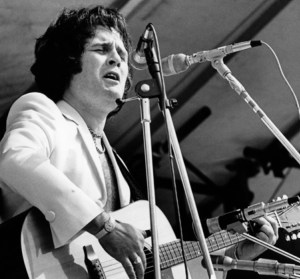 December 29, 1980 – James Timothy “Tim” Hardin was born in Eugene, Oregon on December 23rd 1941. He dropped out of high school at age 18 to join the Marine Corps. (Hardin is said to have discovered heroin in Vietnam.) After his discharge he moved to New York City in 1961, where he briefly attended the American Academy of Dramatic Arts. He was dismissed due to truancy and began to focus on his musical career by performing around Greenwich Village, mostly in a blues style.
December 29, 1980 – James Timothy “Tim” Hardin was born in Eugene, Oregon on December 23rd 1941. He dropped out of high school at age 18 to join the Marine Corps. (Hardin is said to have discovered heroin in Vietnam.) After his discharge he moved to New York City in 1961, where he briefly attended the American Academy of Dramatic Arts. He was dismissed due to truancy and began to focus on his musical career by performing around Greenwich Village, mostly in a blues style.
After moving to Boston in 1963 he was discovered by the record producer Erik Jacobsen (later the producer for The Lovin’ Spoonful), who arranged a meeting with Columbia Records. In 1964 he moved back to Greenwich Village to record for his contract with Columbia. The resulting recordings were not released and Columbia terminated Hardin’s recording contract.
After moving to Los Angeles in 1965, he met actress Susan Yardley Morss (known professionally as Susan Yardley) and moved back to New York with her. He signed to the Verve Forecast label, and produced his first authorized album, Tim Hardin 1 in 1966 which contained “Reason To Believe” and the ballad “Misty Roses” which did receive Top 40 radio play.
His backing band included Lovin’ Spoonful leader John Sebastian on harmonica and jazzman Gary Burton on vibes, but Hardin claimed to be so upset by the strings that were overdubbed on some tracks without his consent that he cried when he first heard them. Still, it was a strong set with a tender low-key, confessional tone, and contained some of his best compositions, such as “Misty Roses”, “How Can We Hang On To A Dream”, and especially “Reason To Believe”, which became something of a signature tune.
Strings also occasionally graced Hardin’s next LP, Tim Hardin 2 (1967), in a more subtle fashion. Another solid collection in much the same vein as the debut, it contained perhaps his most famous song, “If I Were A Carpenter”, which was taken into the US Top 10 in a faithful cover version by Bobby Darin.
These two albums, sadly, represented the apex of Tim’s career; almost all of his best work is contained on them, although he would live another dozen years. Heroin problems and general irresponsibility often made him miss shows or perform poorly; he suffered from pleurisy in 1968, and a tour of England the same year had to be cancelled when he fell asleep on stage at the Royal Albert Hall, shortly after dismissing his backing group in front of the audience. The live Tim Hardin 3 (1968) was a decent set with jazzy backing musicians that introduced some new material along with reprises of previously recorded favorites. But Hardin didn’t record another set of fresh songs in the 60s, although he did perform at Woodstock, where he lived for a while (his performance, however, didn’t make it on to the film of the event).
Many of his songs were covered by prominent artists including Small Faces, Paul Weller, Billy Bragg, Rod Stewart, Weddings Parties Anything, Joan Baez Four Tops, Doc Watson, Robert Plant, Rick Nelson to mention a few. His many songs include “If I Were A Carpenter”, “How Can We Hang On To A Dream?”, “Misty Roses”, “Reason to Believe”, “It’ll Never Happen Again”, “You Got a Reputation”, “Don’t Make Promises”, “Shiloh Town”, “The Lady Came from Baltimore” and “Red Balloon”
Hardin did record a few albums in the early 1970s that were not without bright moments; but, whether due to dope or other factors, his muse seems to have withered; the 1973 record Painted Head didn’t even contain a single original composition. Tim Hardin 9 (also 1973) was his last LP; after years of bouncing around England and the West Coast and fighting health and psychological problems, he died in Los Angeles in 1980 at age 39 from a heroin and morphine overdose.








[…] Macamba0 (20 December 2015). “Tim Hardin 12/1980”. Rock and Roll Paradise. Archived from the original on 28 September 2020. Retrieved 24 July […]